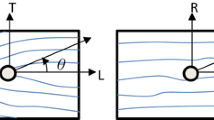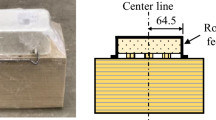Summary
A new testing apparatus was designed and a test method developed to enable the application of axial loads, lateral loads, and controlled ratios of axial to lateral loads to nailed wood joints. The effect of axial load components on ultimate lateral load, joint deformations and several slip moduli were evaluated. These load-slip parameters were determined for three species of wood, three depths of nail penetration, and eight angles of load application.
Several basic equations were examined to quantitatively describe the effect of combined axial and lateral loads. These included Hankinson's formula, a modified stress interaction formula, and a semi-log curve fitting process.
Hankinson's formula proved to be a poor equation to describe the combined load effect, producing errors in excess of 500 percent in some cases. The stress interaction formula modified with a sine function produced an accurate method for describing ultimate load with errors below 15 percent. This is recommended as a design equation for nailed joints loaded in a combined manner. The use of a semi-log curve fitting process and a simple linear regression made it possible to describe the effect of axial load components on stiffness parameters of nailed joints.
Similar content being viewed by others
References
Albert, T. J.; Johnson, J. W. 1967. Lateral holding capacity of power driven fasteners. Forest Prod. J. 17 (9): 50–67
Brock, G. R. 1957. The strength of nailed joints. Bull. For. Prod. Res., London, No. 41
Brown, H. P.; Panshin, A. J.; Forsaith, C. C. 1952. Textbook of wood technology. McGraw Hill Book Company, New York. 783 p.
DeBonis, A. Louis. 1974. Combined axial and lateral loading of nailed joints. Masters Thesis. Colorado State University, Fort Collins, Colorado
Foschi, R. O. 1973. The load-slip characteristics of nails. Dept. of the Environment, Can. For. Ser., Western Forest Products Laboratory. Vancouver, British Columbia. 27 p.
Goodman, J. R.; Bodig, J. 1971. Orthotropic strength of wood in compression. Wood Science 4 (2): 83–94
Hankinson, R. L. 1921. Investigation of crushing strength of spruce at varying angles of grain, Air Service Information Circular Vol. III, No. 259 (Material Section Paper No. 130)
Hoyle, R. J., Jr. 1972. Wood technology in the design of structures. Mountain Press Publishing Company. Missoula, Montana. 370 p.
Kuenzi, E. W. 1955. Theoretical design of a nailed or bolted joint under lateral load. U.S. Forest Products Laboratory Report No. 1951. 31 p.
Mack, J. J. 1960. The strength of nailed timber joints, I, in messmate stringybark. Commonwealth Scientific and Industrial Research Organization. Aust. Div. For. Prod. Tech. Paper No. 9
Mack, J. J. 1966. The strength and stiffness of nailed joints under short duration loading. Commonwealth Scientific and Industrial Research Organization. Aust. Div. For. Prod. Tech. Paper No. 10
Morris, E. N. 1970. An analysis of the load-slip curve for a nailed joint and the effect of moisture content. Journal of the Institute of Wood Science 5 (1): 3–9
Munse, H.; Cox, H. L. 1956. The static strenght of rivets subjected to combined tension and shear. Eng. Exp. Sta. Bull. No. 437. University of Illinois, Urbana. 28 p.
National Forest Products Association. 1973. National design specifications for stress-grade lumber and its fastenings. Washington, D.C.
Norén, B. 1962. Nailed joints—a contribution to the theoretical analysis of yield and strength. Swedish For. Prod. Res. Laboratory Report No. 123B. Stockholm. 8 p.
Perkins, R. H. 1971. Nail withdrawal resistance in plantation red pine grown in Indiana. Forest Prod. J. 21 (6): 29–32
Scholten, J. A.; Molander, E. G. 1950. Strength of nailed joints in frame walls. Agricultural Engineering 31 (11): 551–555
Scholten, J. A. 1962. Effect of nail points on the withdrawal resistance of plain nails. Forest Prod. Lab. Report No. 1226
Scholten, J. A. 1965. Strength of wood joints made with nails, staples and screws. Forest Prod. Lab. Res. Note No. FPL-0100. 16 p.
Stern, E. G. 1950. Grooved nails strengthen house frames. Engineering News Record. April 6. 3 p.
Stern, E. G. 1951. Nail tests show effectiveness of straight over slant driving. Wooden Box and Crate 13 (4): 14–17
Stern, E. G. 1952. Immediate vs. delayed holding power of nails. V. P. I. Wood Research Laboratory Bull. No. 8. 12 p.
Stern, E. G. 1956. Plain-shank vs. fluted vs. threaded nails. V. P. I. Wood Research Laboratory Bull. No. 27. 24 p.
Stern, E. G. 1964. Moisture content of lumber influencing nail holding power. V. P. I. Wood Research Laboratory Bull. No. 53. 3 p.
Stern, E. G. 1964. Load transmission by nails in double shear. V. P. I. Wood Research Laboratory Bull. No. 55. 11 p.
United States Department of Agriculture. 1974. Wood handbook. Agricultural handbook No. 72
United States Department of Agriculture. 1965. Nail withdrawal resistance of American woods. U.S. Forest Service Note No. FPL-093. 5 p.
United States Forest Product Laboratory. 1931. Nail holding power of American woods. U.S. Forest Products Lab. Tech. Note No. 236. 4 p.
Vanderbilt, M. D.; Goodman, J. R.; Criswell, M. E. 1974. Service and overload behavior of wood joist floor systems. Journal of the Structural Division, A.S.C.E. 100 (ST 1): 11–29
Westman, E. F.; McAdoo, J. C. 1969. Nail withdrawal resistance of Douglas-fir and western hemlock. Forest Prod. J. 19 (5): 38
Wilkinson, T. L. 1971. Theoretical lateral resistance of nailed joints. Journal of the Structural Division, A.S.C.E. 91 (ST 5): 1381–1398
Wilkinson, T. L. 1972. Analysis of nailed joints with dissimilar members. Journal of the Structural Division, A.S.C.E. 98 (ST 9): 2005–2013
Wilkinson, T. L. 1972. Effect of deformed shanks, prebored lead holes, and grain orientation on the elastic bearing constants for laterally loaded nailed joints. Forest Prod. Lab. Res. Paper No. 192. 13 p.
Author information
Authors and Affiliations
Additional information
The authors wish to acknowledge the National Science Foundation for financial support under NSF Grant GK-30853 entitled “A Rational Analysis and Design Procedure for Wood Joist Floor Systems” and the McIntire-Stennis Cooperative Forestry Research Program for additional financial support.
Rights and permissions
About this article
Cite this article
DeBonis, A.L., Bodig, J. Nailed wood joints under combined loading. Wood Science and Technology 9, 129–144 (1975). https://doi.org/10.1007/BF00353391
Received:
Issue Date:
DOI: https://doi.org/10.1007/BF00353391




